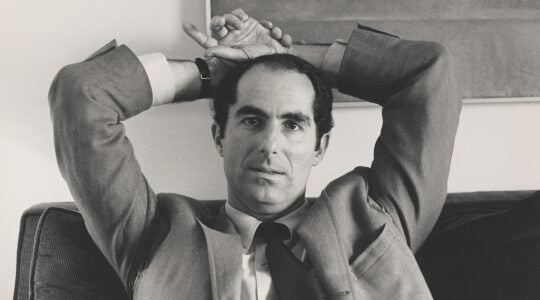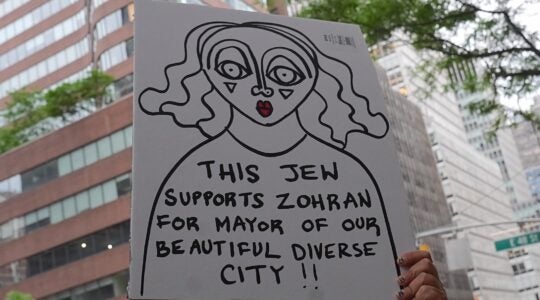Even if you’re a very casual observer of the U.S. Jewish community and a friend who knows nothing about it asks you, “How big a phenomenon is Jewish intermarriage?” you’d probably be able to answer, “It’s pretty big.”
There is a pantheon of proudly Jewish celebrities from Jon Stewart to Natalie Portman to Michael Douglas to Scarlett Johansson who have intermarried. (Douglas and Johansson are also children of intermarriage themselves.)
If you’re more than just a casual observer of American Jewry, let’s say you’re a rabbi, you may know a bit more about the magnitude of Jewish intermarriage. You may know the rate at which Jews intermarry. The intermarriage rate is a number that the organized Jewish community has fixated on for decades, at least since the 1990 National Jewish Population Study (NJPS) found that in the prior five years, 52 percent of Jews who married had taken spouses from other religious backgrounds.
The most recent take on the subject, provided by the Pew Research Center, found that the rate now stands at 58 percent. But I would argue that this intermarriage rate tells us very little about the actual size of intermarriage, and may actually hinder our understanding.
Because what if your unknowing friend then asks, “OK, so how many is that?” Do you know how many intermarried households there are in the United States today? And how it compares to the number of in-married households?
I believe that even among the most serious observers of American Jewry, almost nobody knows that number, because it’s never provided by those very same studies that give us the intermarriage rates! Not by the NJPS, and, surprisingly, not by the Pew study.
So here it is, for the first time anywhere (that I’ve seen): Of all U.S. households containing at least one Jewish spouse, there are 1,166,000 intermarried households and only 742,000 in-married households.
Feel free to reread that last sentence and let it sink in.
For you math wonks out there, I’ll explain how I guesstimated those numbers below, but first a few points. Most importantly, why does it matter?
There has been a sweeping change in the demography of American Jewry over the last 30 years, yet many sectors of the organized Jewish community have not adjusted. By not fully understanding the magnitude of the phenomenon, and not identifying, let alone embracing, the changes needed to serve the interests and needs of a more diverse and mixed population, we’re now seeing major institutions crumble and entire movements listing like storm-battered ships. The societal changes have been dramatic, but the responses, incremental.
Some will argue that not all of those intermarried households consider themselves Jewish households, and they’d be correct. Most intermarried households are not connecting to the organized Jewish community or to religious Judaism. And yet, the Pew survey found that 61 percent of intermarried households are raising their children with some Jewish identity. And that even as the number of intermarried households has ballooned, the percentage of children of intermarriage who consider themselves Jewish has also increased dramatically, putting the lie to those who would claim that “intermarriage” is synonymous with “assimilation out of Judaism.”
A better understanding of the statistics also matters because it shows that the number of intermarried households is increasing much faster than the number of in-married households. So the gap is widening. Yet the misunderstanding fuels a continued conversation about whether there’s still something we can do about it, as if the results of the trend aren’t yet in.
There was no clearer demonstration of the confusion about intermarriage rates than when the director of religious surveys for Pew itself was quoted as saying that “in a silver lining for Jewish leaders, intermarriage rates have leveled off …holding steady at 60 percent since the mid-1990s.”
To understand how much of a distortion that is, we need to do math, sorry, but it’s not advanced calculus: The 58 percent intermarriage rate means that out of 100 Jews who got married, 58 of them married someone not Jewish, resulting in 58 intermarried households. (I presume you’re still with me.) What happens to the other 42 Jews? They in-married, but because each in-marriage requires two Jews, they marry each other, resulting in only 21 in-married households.
So the 58 percent rate of intermarriage that has supposedly “leveled off” is still producing intermarried households at a rate of almost three to every one in-marriage household. Even if this rate “holds steady,” the rapid increase of intermarried households will continue. Married households matter because the overwhelming majority of children in our community are born to married couples. And that’s why the future of the non-Orthodox organized Jewish community belongs to those movements and organizations that are successfully integrating Jews and non-Jews into programs that are meaningful regardless of participants’ backgrounds, and who understand just how very big a demographic wave it is they’re riding.
How I got my numbers: the Pew Research Center Survey of U.S. Jews estimated the total adult Jewish population at 5.3 million (p. 23), and said that “about half of Jewish respondents are currently married … 51% today” (p. 35-36). I went with 50 percent to be conservative, or 2,650,000 married Jews. The study said, “56 percent of married Jews have a Jewish spouse, while 44 percent of Jewish respondents are married to a non-Jew” (p. 36). Note: this 44 percent intermarriage rate is over all intact marriages, whereas the 58 percent intermarriage rate discussed above is only for marriages since 2000.) Forty-four percent of 2,650,000 married Jews is 1,166,000 intermarried Jews, which means 1,166,000 intermarried households. Fifty-six percent of 2,650,000 is 1,484,000 in-married Jews, but because they are married to each other, it means 742,000 in-married households.
Paul Golin is associate executive director of Big Tent Judaism/Jewish Outreach Institute (JOI.org).
The New York Jewish Week brings you the stories behind the headlines, keeping you connected to Jewish life in New York. Help sustain the reporting you trust by donating today.




